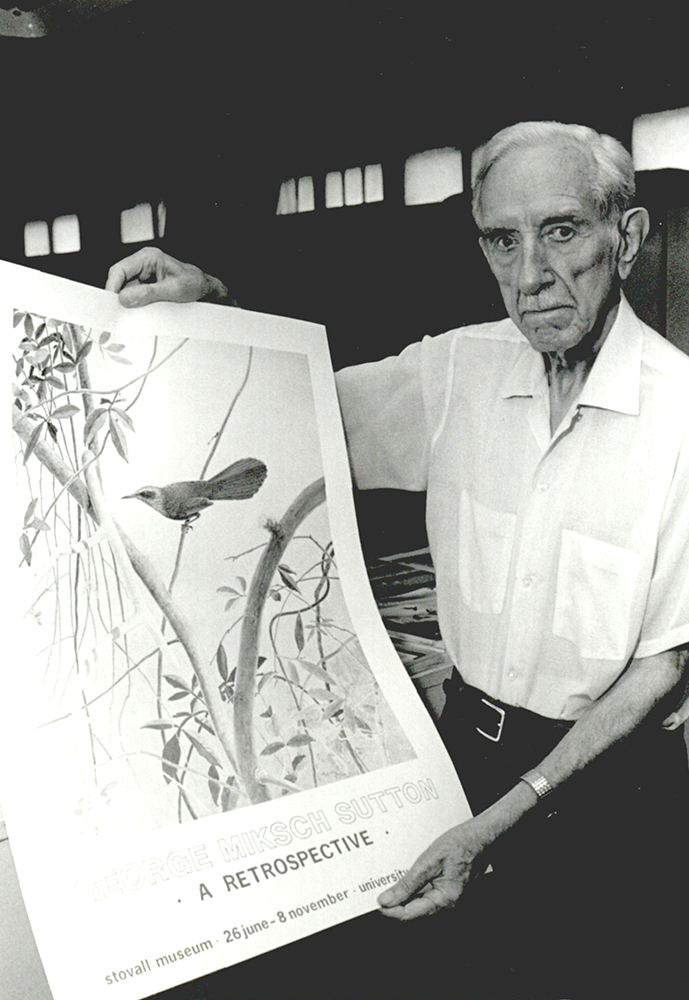
The Encyclopedia of Oklahoma History and Culture
SUTTON, GEORGE MIKSCH (1898–1982).
Born on May 16, 1898, in Bethany, Nebraska, world-renowned ornithologist George Miksch Sutton was the son of Harry T. and Lola Anna Miksch Sutton. Harry Sutton, a minister and teacher, frequently moved his family. If there was a positive aspect to George Sutton's itinerant youth, it was that he learned about the regional variations in birds and their habitats, a lifelong passion.
At age five Sutton enjoyed his copy of Frank M. Chapman's book Bird-Life. By age twelve he had seen his first bird drawing published and was a member of the American Ornithologists' Union. Four years later he had published articles in The Oölogist (a journal devoted primarily to the study of bird eggs) and Bird-Lore. Perhaps one of the most important events of his life occurred when he began corresponding with well-known ornithological artist Louis Agassiz Fuertes. Fuertes not only gave Sutton advice on drawing birds but invited him to spend time with his family during the summer of 1916.
In 1918 Sutton worked at the Carnegie Museum in Pittsburgh, Pennsylvania, where he was in charge of the egg collection and went on field expeditions with Carnegie staff to Labrador and other northern regions. Rather than graduating with a bachelor's degree from Bethany College in West Virginia in 1919, he was expelled for leading a student revolt against mandatory Reserve Officers' Training Corps (ROTC) training. The college later granted his degree in 1923. From 1925 to 1929 Sutton served as Pennsylvania's state ornithologist and wrote his first book, An Introduction to the Birds of Pennsylvania (1928).
After leaving Pennsylvania, Sutton received a doctorate from Cornell University in 1932. "Doc," as he became known, stayed at Cornell as curator of the Louis Agassiz Fuertes Memorial Collection of Birds. During World War II Sutton served in the U.S. Army Air Corps and tested Arctic survival gear. After the war he worked at the University of Michigan. Wanting a full-time faculty post, he became zoology professor at the University of Oklahoma in 1952. Although he officially retired in 1968, he remained as curator of birds at the Stovall Museum of Science and History and as an emeritus professor. His book Oklahoma Birds: Their Ecology and Distribution With Comments on the Avifauna of the Southern Great Plains (1967) encouraged ornithological study throughout the state. He supported the Oklahoma Ornithological Society with money, his artwork, knowledge, and enthusiasm. Sutton added thousands of bird specimens as well as hundreds of paintings and sketches to the University of Oklahoma. These are housed at the Sam Noble Oklahoma Museum of Natural History.
Sutton wrote thirteen books, eighteen monographs and museum publications, and 201 journal articles and illustrated at least eighteen books. It was said that he sought recognition as an artist and not merely as an illustrator. He stressed the importance of accuracy and was a master with pen and ink and watercolor, preferring to paint birds from real life. His painstaking illustrations of a beak, a foot, or the underside of a wing were unmatched. Sutton was one of the first ornithologists to study and illustrate baby bird development.
A member of numerous professional and honorary societies, Sutton received an honorary doctorate from Bethany College in 1952 and won the John Burroughs Medal for conservation writing in 1962. In 1967 he was named to the Oklahoma Hall of Fame. In 1972 the Icelandic government awarded him the Knight Cross of the Order of the Falcon for his study of Icelandic birds and later used one of his paintings of a gyrfalcon on a postage stamp. Numerous wildlife refuges were named after Sutton, including the George Miksch Sutton Avian Research Center near Bartlesville. A true Renaissance man, Sutton made numerous contributions to the College of Fine Arts at the University of Oklahoma. In recognition of his philanthropy the college inaugurated its concert chamber music series, the Sutton Series, in 1982.
Sutton died in Norman, Oklahoma, on December 7, 1982. His body was cremated and his ashes spread in the Black Mesa country of western Oklahoma.






